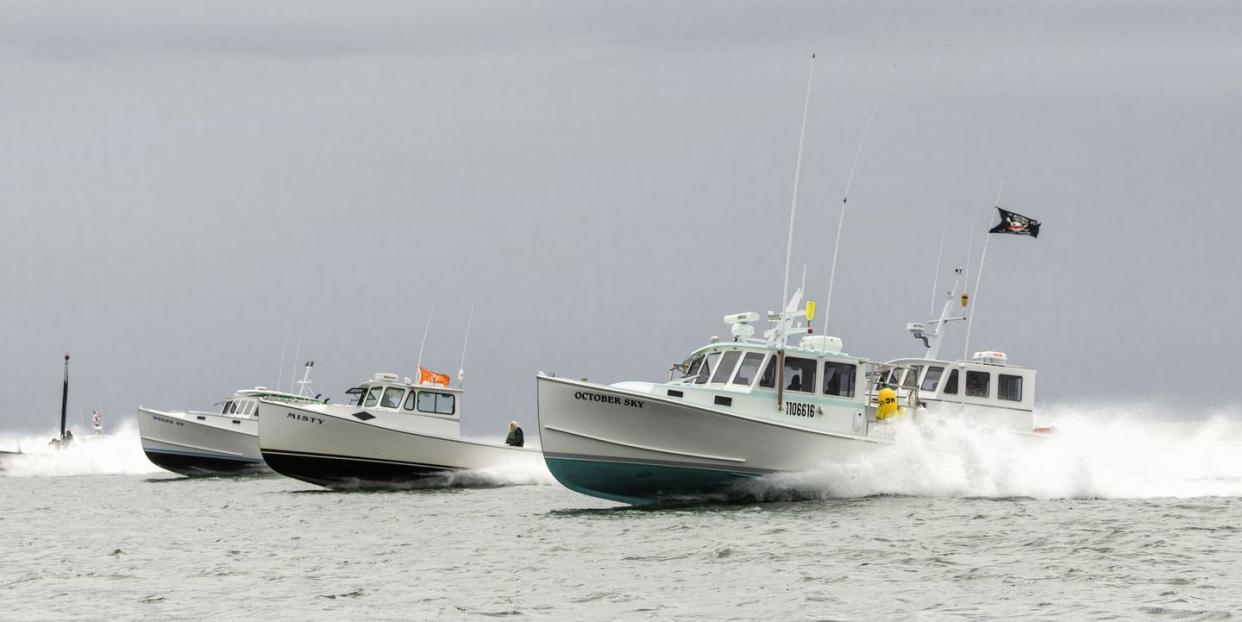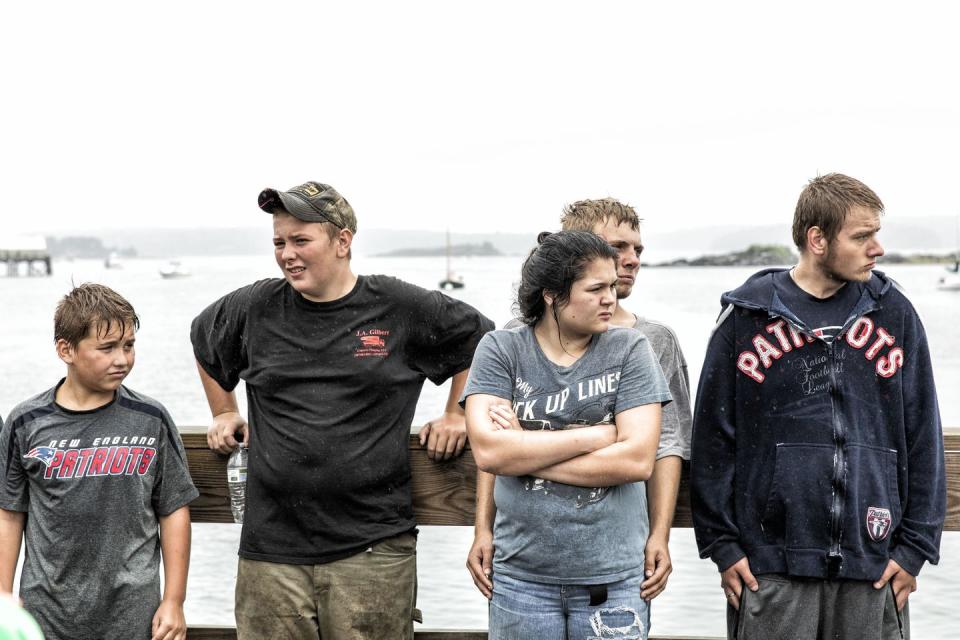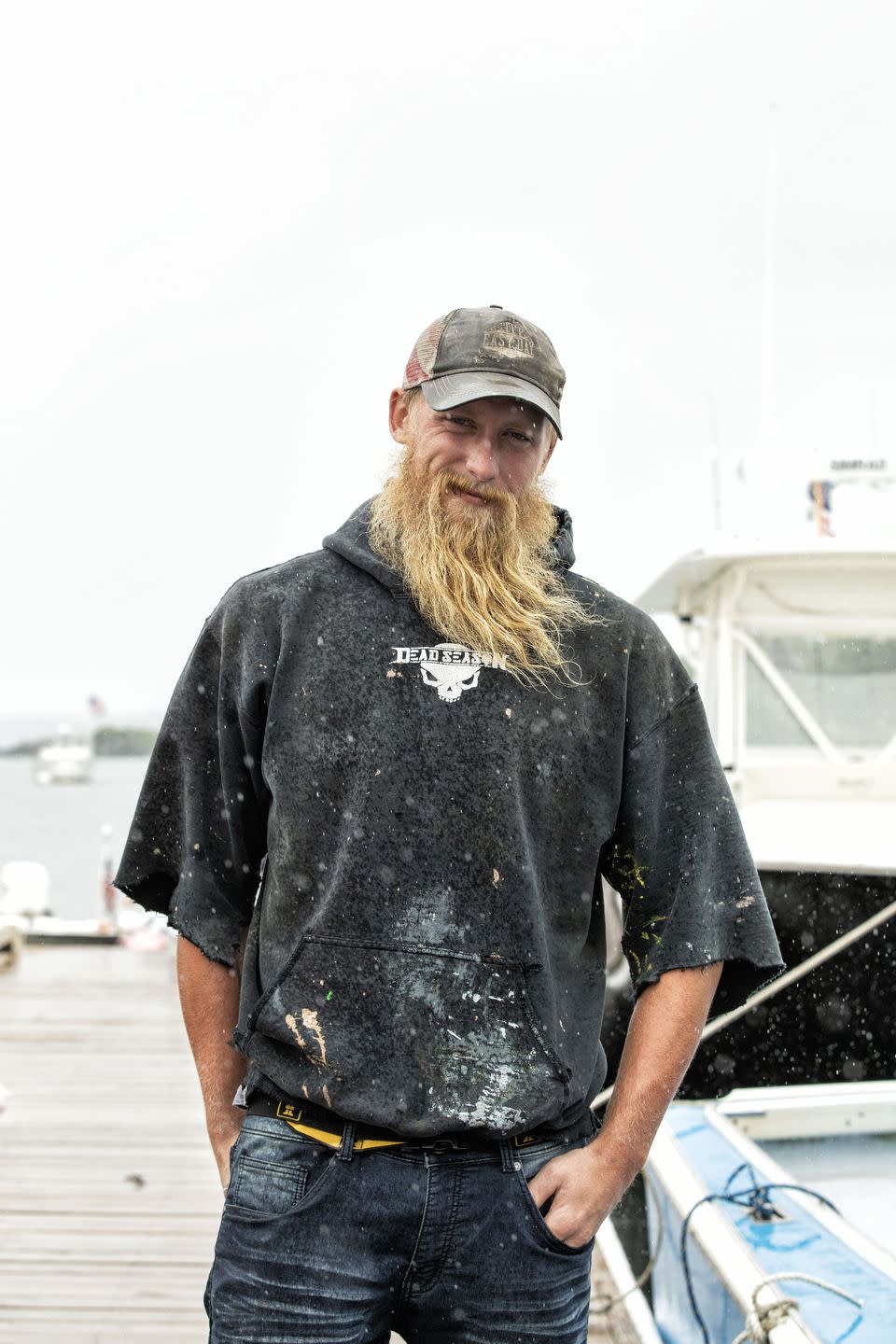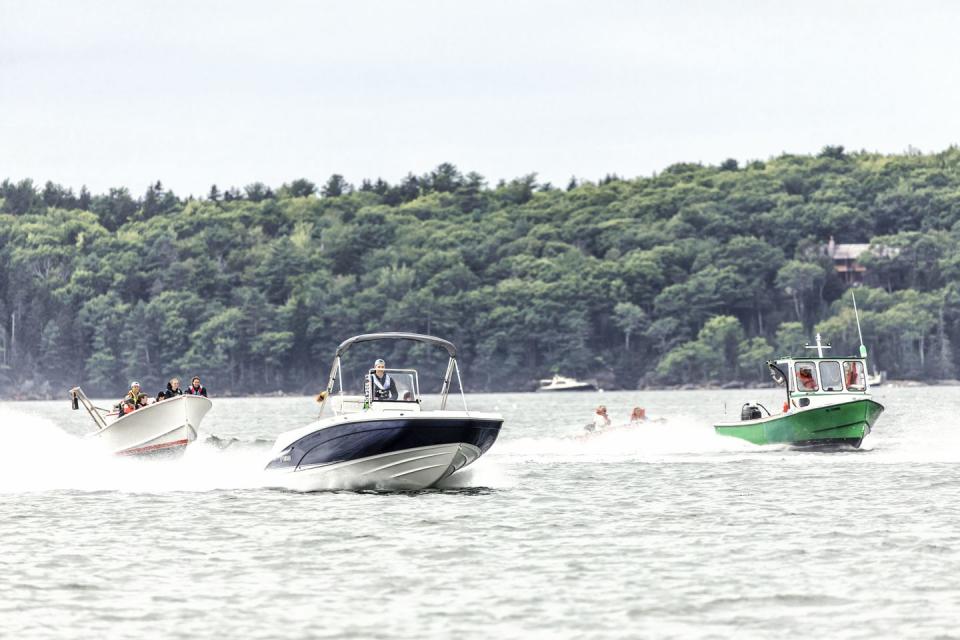What It's Like To Go Lobster Boat Racing

When you ask a Maine lobster-boat racer what kind of horsepower he’s running, the first answer will always be a dutiful recitation of the factory specification, usually delivered with a smirk. Ask again, and the second answer might be more like the truth. Like if his 18.1-liter CAT diesel was rated for 700 horsepower before he made a few mods—free-flowing intake and exhaust, at the very least—maybe he’d acknowledge it’s more like 800 horsepower now.
If the first answer is 1,000, the second might be more like 1,200. But the reality is that nobody knows. It’s not like you can dyno-test a commercial fishing boat. All you know is that when you’re done hauling 600 lobster traps, you get back to the harbor a little quicker than you did before. And when you enter a race some weekend over the summer, you’ve got some extra speed in your back pocket.

Yes: Maine lobster-boat races. It sounds like a goof, like the fall pumpkin races that they hold in Damariscotta, where they mount outboard motors on giant gourds and race around the harbor. But it’s serious, an annual circuit with events up and down the coast.
Some of the boats are purpose-built racers, trailered to each event, cammed-up big-blocks bursting through their decks. They’re lobster boats in the same way that Joey Logano’s Nascar race car is a Mustang. But most of the entrants are actual commercial fishing vessels, work boats that happen to be screamin’ fast. Their owners might make a 100- mile trip, or more, just to race for a minute or so.
And yeah, there are prizes—bait, maybe a set of tires from a local sponsor—but the real reason they’re there is for the thrill. I know, because I used to race.
Back in high school, in the ’90s, my dad was a lobsterman and we had a little 21-foot Novi boat with a Volvo-Penta four-cylinder. The last time I raced it, at the Merritt Brackett race in Pemaquid, I came in fourth in the Novi class, just missing the podium. I’ve always dreamed of making a return and avenging that performance.
Today, I’m attempting just that. Race 3 is “Clamdiggers and lobster-pickers, 71 horsepower and over, skiffs 16 feet and over.” And I brought a skiff, of sorts—a new Yamaha 210 FSH center console. Which lands me in trouble right from check-in, where I forget to lie.
Registration is at The Contented Sole, a waterfront restaurant that serves as the staging area for the Pemaquid race. A guy with a laptop asks me questions as he logs my entry. What make is the boat? “Yamaha,” I say. Make of engine? “Yamaha, inboard,” I say. Then the touchy question, the one nobody wants to answer straight. Race classes are determined by horsepower, so if you’re in, say, race 13—diesels 651 to 800 horsepower—you don’t want to stray into the next class, which is 801 horsepower to infinity.

The registrar asks me how much power my engine has, and I reply, “One thirty...each.” He looks up from his laptop and declares, “That’s gonna be a problem.” It’s one of the quirks of lobster boats, and hence lobster-boat racing: You might have 1,000 horsepower, but you only have one engine. Hell, back in 1994 they gave me crap because the Volvo had dual carbs. But we work out an agreement wherein I’ll run in the skiff class but not claim any prizes if I win. Fair enough. I’m not here for prizes. I’m here for glory.
The race course is a little more than a quarter-mile of open water, demarcated with buoys, with spectators anchored on either side, some of the boats rafted together to form makeshift party barges. A marine patrol officer tells me that this crowd is more mellow than it used to be—some years ago, he had to chase a guy across the rafted boats to arrest him. Ahead of the races, I putter around to see if I know anybody, and soon encounter my high school friend Aaron anchoring his boat near the finish line. I tell him I feel a little out of place without a lobster boat.
“Trust me,” he says, “that Yamaha’s hauled just as many traps as some of the boats that are racing today.”
Another guy, circling near the starting line in a skiff, calls me out as the interloper that I am. “Why’ve you got a buoy?” he asks. He’s referencing the lobster buoy lashed to the side of the console. Each lobsterman has his own colors on his buoys, and you show a display buoy on your boat so anyone can tell at a glance that you’re hauling your own traps and not somebody else’s. I’ve got one of my father’s old buoys—yellow, black, and orange—on the 210 FSH. So I tell the guy in the skiff that this is my buoy, for my traps.
“Your boat’s too clean to haul traps,” he shoots back. “You’ve still got the price tag on it.” I figure he’s busting balls until I return to the dock and see that the Yamaha in fact has some kind of dealer inventory tag zip-tied to the bow eye. Whoops. Amateur hour here.
Back at the dock, I tie up next to Gary Genthner, captain of the Lisa Marie. His boat is a 34-foot Libby with a 13-liter Iveco diesel. I ask what he’s pushing for horsepower and he says 700. Then I ask again and, per protocol, he laughs and says, “Or maybe more like 800.” Genthner says that the overkill power isn’t just about putting on a show at the races. Akin to how a Corvette can get 30 miles per gallon loafing along at low rpm, the big Iveco doesn’t have to work too hard when he’s actually out hauling traps.
“I might burn 20 gallons of fuel all day long when I’m just hauling,” he says. Wide open, though, Lisa Marie does about 40 mph. You could barefoot waterski behind this thing, and it isn’t even in the top horsepower class.
My class is one of the first to run, and thus also one of the more chaotic. The competitors check in the with pace boat at the far end of the course and then attempt to remain in some semblance of a formation as everyone pulls into position for the flying start. The idea is that all the boats are making headway speed when the flagger on the pace boat signals that the race is on, prompting everyone to jam their throttles and speed back to the mouth of the harbor.
But it’s a goat rodeo, all of us pumped on adrenaline, and half the boats are on plane, skimming across the water, before the flag even drops, prompting a restart and some salty reprimands over the VHF radio.

The second time around, we get a clean start. I shove the Yamaha’s twin throttles and enjoy my unfair competitive advantage—not only twin high-output three-cylinder inboards, but jet drives, which provide instantaneous acceleration. Some of these guys have pretty sizable outboards, and I have a moment where I’m worried. But the 210 jumps on plane and steadily begins pulling away. As I cross the finish line, the GPS shows 45 mph, probably twice as fast as my old boat used to go. Vengeance is mine! Unofficially, of course.
Officially, I’m just a twin-engine out-of-state cheater, but I’m still giddy with the thrill of faux first place. I pull to the side of the course to watch the other races, then head to The Contented Sole to raft up at the dock for the postrace celebrations.
There, I meet Matt Johnson, part of the Whistlin’ Dixie crew. I ask if its 1,000-horsepower CAT is stock. “Yeah, it’s stock!” he says, laughing. “Fishermen always tell the truth, right?”
Matt—a champion swimmer in high school and a certified diver now—has wet hair because he just dove under a rival boat, Motivation, to cut a tangled trap line out of the prop. This is a competition, but lobstermen are a tribe, one that has internal squabbles over rules and territory but is ultimately united enough to manage and sustain a fishery across generations. Johnson’s uncle, Andy, gestures to another lobsterman across the dock and says, “We were wrestling once in a bar and went right through the front window. We’re like brothers. We were racing them today.”
The emcee for the prize ceremony announces that they’re getting started: “First-place winners, you can go get a free bucket of bait.” I stick near the announcer because I’m curious to see who’ll get the inaugural Popular Mechanics Flying Claw award, which I endowed with $100 to help improve the mood of the registration guy who was iffy on the whole twin-engine thing.
I’m delighted to see that the prize goes to Gabe Hanley, an 11-year-old kid who won the 25-horsepower skiff class. I walk over to ask him what’s next for his lobster-boat racing career. He’s shy but he knows the answer, because it’s the same answer for anyone here.
“A bigger boat,” he says, looking up from his rubber boots. "And a bigger motor, I guess."
This article appeared in the July/August 2019 issue of Popular Mechanics. You can subscribe here.
('You Might Also Like',)

